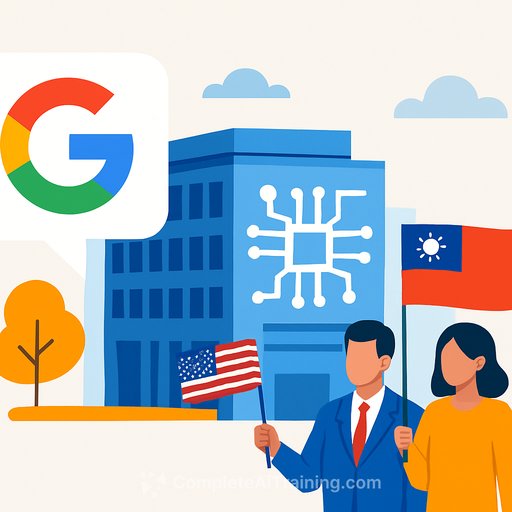Google opens its biggest AI hardware engineering hub outside the U.S. - in Taiwan. Here's what product teams should do next
Google has launched its largest AI infrastructure hardware engineering centre outside America in Taiwan. The move signals firm confidence in Taiwan as a reliable tech partner and a key node in AI hardware design, testing, and deployment.
The centre will develop and validate technology used across Google's global data centres and devices. As Google's VP of Engineering Aamer Mahmood put it, "The technology developed and tested in Taipei is deployed in Google data centres around the world."
Why Taiwan matters for AI hardware right now
Taiwan anchors the AI supply chain. It's home to TSMC, the leading contract chip manufacturer, whose advanced components power companies like Nvidia. That proximity to advanced silicon, packaging, and system integration shortens loops between design, test, and scale.
For product leaders, this isn't just optics. It's a signal: AI hardware roadmaps will increasingly revolve around Taiwan's ecosystem-component availability, manufacturing slots, and on-site validation capacity.
What this means for product development teams
- Plan for silicon-led timelines: Your release plans will be gated by accelerator availability (GPU, custom ASIC, memory like HBM) and packaging capacity. Sync product milestones to foundry and OSAT cycles early.
- Design for power and heat as first-class constraints: High-density AI compute pushes 30-60kW+ per rack. Budget for liquid cooling options, power delivery, and floor load from day one-retrofits are expensive and slow.
- Qualify multiple configurations: Build test matrices covering different accelerator SKUs, memory stacks, and interconnects. Ensure firmware, drivers, and networking are validated across variants to avoid last-minute blocks.
- Integrate supply risk into PRD and OKRs: Treat lead-time exposure and single-source chips as measurable risks. Add mitigation objectives (alternates, staggered BOMs, flexible enclosures) directly into the roadmap.
- Co-locate with the ecosystem where it helps: ODM engagement, rack-level validation, and thermal tuning run faster with on-the-ground access. Expect Taipei trips or extended embeds to pay off in cycle time and quality.
- Tighten security posture on AI stacks: Taiwan has warned about risks from Chinese-developed AI systems such as DeepSeek. If your product or data pipelines touch those stacks, conduct legal, security, and compliance reviews and define clear usage boundaries.
- Architect for global deployment: What's validated in Taipei should translate cleanly to regional data centre standards. Document site requirements (power, cooling, network fabrics) and lock them with ops partners early.
Geopolitics: partnership and policy
U.S.-Taiwan ties are deepening. The de facto U.S. ambassador to Taiwan, Raymond Greene, called this a "new golden age in U.S.-Taiwan economic relations." That context matters for long-term planning, vendor selection, and compliance frameworks.
Taiwan's president, Lai Ching-te, framed the new centre as proof of long-term commitment and a signal of Taiwan's role as a hub for secure, trustworthy AI. For product orgs, expect continued encouragement to work with vetted suppliers and to maintain strong data security controls.
Action checklist for the next 90 days
- Re-baseline your AI hardware roadmap against supply signals from Taiwan-based partners (foundry slots, CoWoS/advanced packaging capacity, memory constraints).
- Stand up a power/thermal tiger team to validate your next two releases under liquid-cooled and air-cooled scenarios.
- Pre-book lab time for rack-level validation and burn-in. Add buffer weeks for firmware and driver updates.
- Update supplier risk models with scenario plans (dual-source parts, staggered configurations, phased feature flags).
- Run a security review on AI vendors and models-document acceptable use, data boundaries, and monitoring.
- Brief execs on geopolitical and compliance factors tied to U.S.-Taiwan cooperation so procurement and legal stay ahead of policy changes.
Why this is good news for builders
Concentration of AI hardware engineering in Taiwan shortens the distance between idea, silicon, and deployment. Faster validation loops mean fewer surprises late in the cycle, better performance tuning, and more predictable launches-if you wire your team into the ecosystem early.
Helpful resources
- TSMC - overview of manufacturing leadership and technology nodes that drive AI hardware supply.
- Reuters Technology - ongoing reporting on AI supply chains, policy, and corporate moves.
Level up your team's AI capability
If your product roadmap touches AI hardware, infrastructure, or model-driven features, upskilling your team is leverage. Explore role-based tracks here:
AI courses by job - build practical skills that ship
Bottom line: Google's move concentrates more AI hardware know-how in Taiwan. Product teams that align their roadmaps, suppliers, and validation plans to that reality will ship faster with fewer surprises.
Your membership also unlocks:






